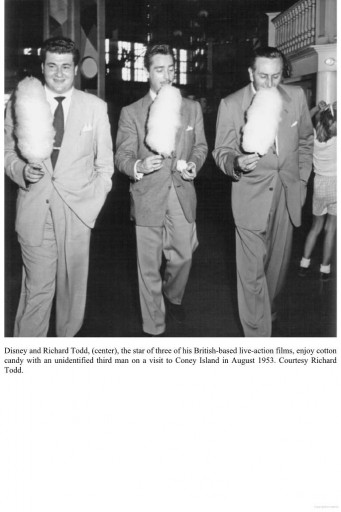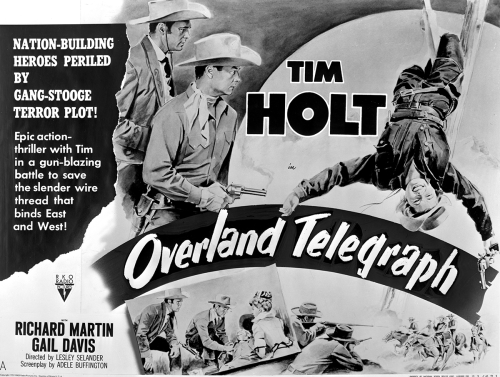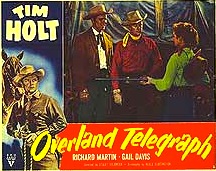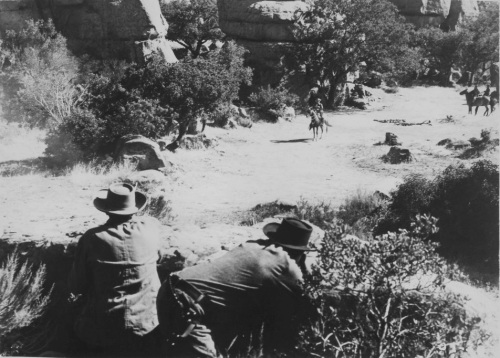
I have recently purchased a book – The Animated Man – A Life of Walt Disney.
Written by Michael Barrier.
In his research he and his wife had travelled to England and met up with actor Richard Todd who became a personal friend of Walt Disneyand this is the article he wrote about that meeting :-
Meeting Richard Todd – by Michael Barrier :-
Richard Todd, the star of three of Walt Disney’s first live-action films, died in England on December 3, 200 at the age of 90. For Walt Disney he appeared in The Story of Robin Hood and His Merrie Men (1952), The Sword and the Rose (1953) and Rob Roy the Highland Rogue (1954). He appeared in many other films, too, and was nominated for a best-actor Oscar for his role in The Hasty Heart (1949). He was a true war hero, as one of the first British paratroopers to land in Normandy. He was, in short, a dashing and glamorous figure, and, as my wife and I learned on June 22, 2004—just a few weeks after Todd took part in ceremonies commemorating the fiftieth anniversary of D-Day—a delightful luncheon companion.
 We were in England during an extended research trip to Europe, for The Animated Man: A Life of Walt Disney. I had been in touch with Todd by mail and email for some months, and we had agreed to meet for lunch at Grantham, in Lincolnshire, about an hour’s train trip north of London, near Little Humby, the village where Todd was living then. We’d had no confirmation from Todd of our plans in the days just before our scheduled meeting, and so Phyllis and I felt some apprehension when we got off the train at Grantham.
We were in England during an extended research trip to Europe, for The Animated Man: A Life of Walt Disney. I had been in touch with Todd by mail and email for some months, and we had agreed to meet for lunch at Grantham, in Lincolnshire, about an hour’s train trip north of London, near Little Humby, the village where Todd was living then. We’d had no confirmation from Todd of our plans in the days just before our scheduled meeting, and so Phyllis and I felt some apprehension when we got off the train at Grantham.
We needn’t have worried. Waiting on the platform for us was a very dapper elderly man, using a cane but immediately recognizable as Richard Todd. As Phyllis said—she had become a fan as we watched a dozen or so Richard Todd movies in preparation for the trip—he still had those twinkling blue eyes. His handsome necktie, he told us later, bore the insignia of his Royal Air Force unit.
Todd drove us in his Mercedes to the Angel and Royal, an 800-year-old Grantham hotel where King Richard III once held court in what was now the main dining room. It was closed for lunch, unfortunately, and so we would have lunch in the bar. As we waited for our table to be made ready, Richard suggested rather gingerly that perhaps we might have something to drink before lunch. When I proposed Bloody Marys, he readily assented.
We talked about Walt Disney and the Disney films over the excellent lunch that followed, Richard Todd expanding on what he had already written about his Disney experiences in the two volumes of his autobiography, Caught in the Act and In Camera (neither of which was ever published in the U.S., although copies are available through used-book dealers). You’ll find quotations from our interview in The Animated Man, along with a photo of Todd with Walt at Coney Island, which he sent me later.
As I listened to Todd at lunch, and a few weeks later on tape, the years fell away; his voice was still that of the strikingly handsome young actor who was easily the most successful Robin Hood on the screen, excepting only Errol Flynn (the publicity photo at left above is of Todd in that role). At 85 he was still very much a movie star, in other words, and in the best sense: not as an ego but as a presence. I’m grateful that I got to spend a couple of hours with him.
After lunch, Phyllis and I took photos of ourselves with Richard Todd; that’s her with him in the photo above. And then he drove us back to the Grantham station, for our return trip to Kings Cross station. A lovely day.










 We were in England during an extended research trip to Europe, for The Animated Man: A Life of Walt Disney. I had been in touch with Todd by mail and email for some months, and we had agreed to meet for lunch at Grantham, in Lincolnshire, about an hour’s train trip north of London, near Little Humby, the village where Todd was living then. We’d had no confirmation from Todd of our plans in the days just before our scheduled meeting, and so Phyllis and I felt some apprehension when we got off the train at Grantham.
We were in England during an extended research trip to Europe, for The Animated Man: A Life of Walt Disney. I had been in touch with Todd by mail and email for some months, and we had agreed to meet for lunch at Grantham, in Lincolnshire, about an hour’s train trip north of London, near Little Humby, the village where Todd was living then. We’d had no confirmation from Todd of our plans in the days just before our scheduled meeting, and so Phyllis and I felt some apprehension when we got off the train at Grantham.



